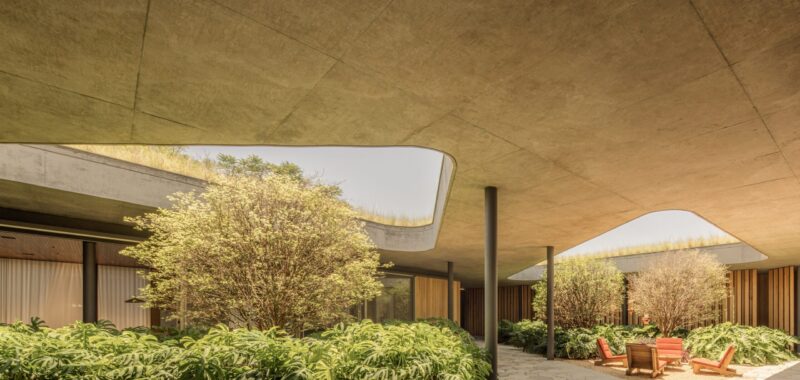When imagining a home, people envision themselves living a version of what they’ve seen before: a townhouse, a villa, or a plant-filled high-rise. This was not the case for a Brazilian family of five, who sought a sustainable home truly immersed in nature. Tucked away in the countryside of São Paulo, their three-level residence is unlike any other in the area or beyond—almost concealed within its hilly surroundings, as though produced by nature itself. For example, a green roof or a landscaped terrace are camouflaging, organic elements—and they’re brilliant sustainability tools, too. Not only do they help lower the heat gain of a building’s interior, they facilitate better air circulation that in turn reduces the building’s energy consumption. Designed with these considerations in mind, this house in Porto Feliz, Brazil has it all.
The picturesque town of Porto Feliz, with the Tietê River running through it, is enveloped by lush greenery and offers a tranquil escape for those seeking a blend of urban sophistication and rural charm. This natural landscape is central to the philosophy of Bernardes Arquitetura, the Brazilian architectural practice behind the project. “We used to say that the site tells us what the project should be; we just have to listen carefully,” the firm explains. “Here, we have a sloping lot, so it was a natural decision to take advantage of this and design a house in continuity with the topography.”
At first glance, you cannot actually tell where the verdant landscape begins or the sustainable home ends. The ‘living’ green roof extends almost organically from street level, in continuity with the existing terrain of the site, while a large balcony juts out to widen the view across the landscape. “From the first meeting, the clients wished [for] a discreet house that would blend into the landscape and be invisible to passersby,” Bernardes Arquitetura shares.
Ensuring an abundance of natural light was a crucial part of the brief, achieved through vertical openings along the wide roof and scattered skylights. These design choices extend beyond mere aesthetic appeal. “A green roof can play a crucial role in reducing cooling costs and energy waste,” the architects explain. Augmenting the planet-friendly design of the green roof, a set of solar panels next to the house feeds into an electrical system. Strategically positioned brises-soleil, or permanent sun-shading structures, on the east and west sides protect areas from direct sunlight.
A central courtyard forms the heart of the residence, which is segmented into standalone spaces, or ‘cores,’ connected with a single roof wrapped around it. “Organized in small pavilions circling an indoor garden, the home is designed to bring the green and the natural light inside, creating a cozy atmosphere,” the architects explain. Sliding glass panels allow the homeowners full access to an outdoor/indoor experience, creating an uninterrupted connection to not just their surroundings, but to their social and entertainment areas as well.
You will find the gathering and wellness areas in the lower level of this Brazil home, as well as the guest rooms. A spiral staircase opens skyward and creates a sensory passage to the swimming pool and terrace, both located on the upper floor. Inside, the architects collaborated with various local designers to custom-build every piece of furniture and decor, from sofas and armchairs to shelves and lighting. “Since the concrete makes for a such a hard and cold structure, we aimed to bring softness and coziness to the interiors. The use of natural wood and a warm palette applied to the soft furnishings created softness and a sense of organicity,” the architects explain.









